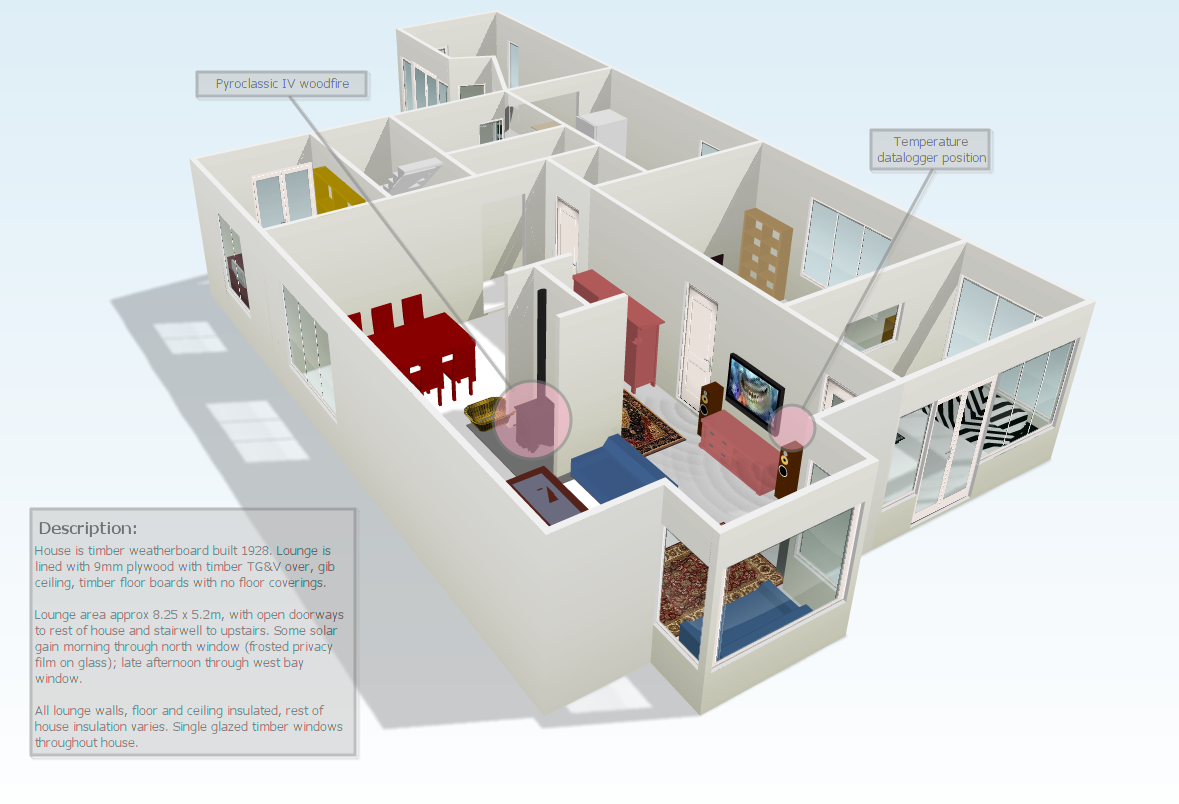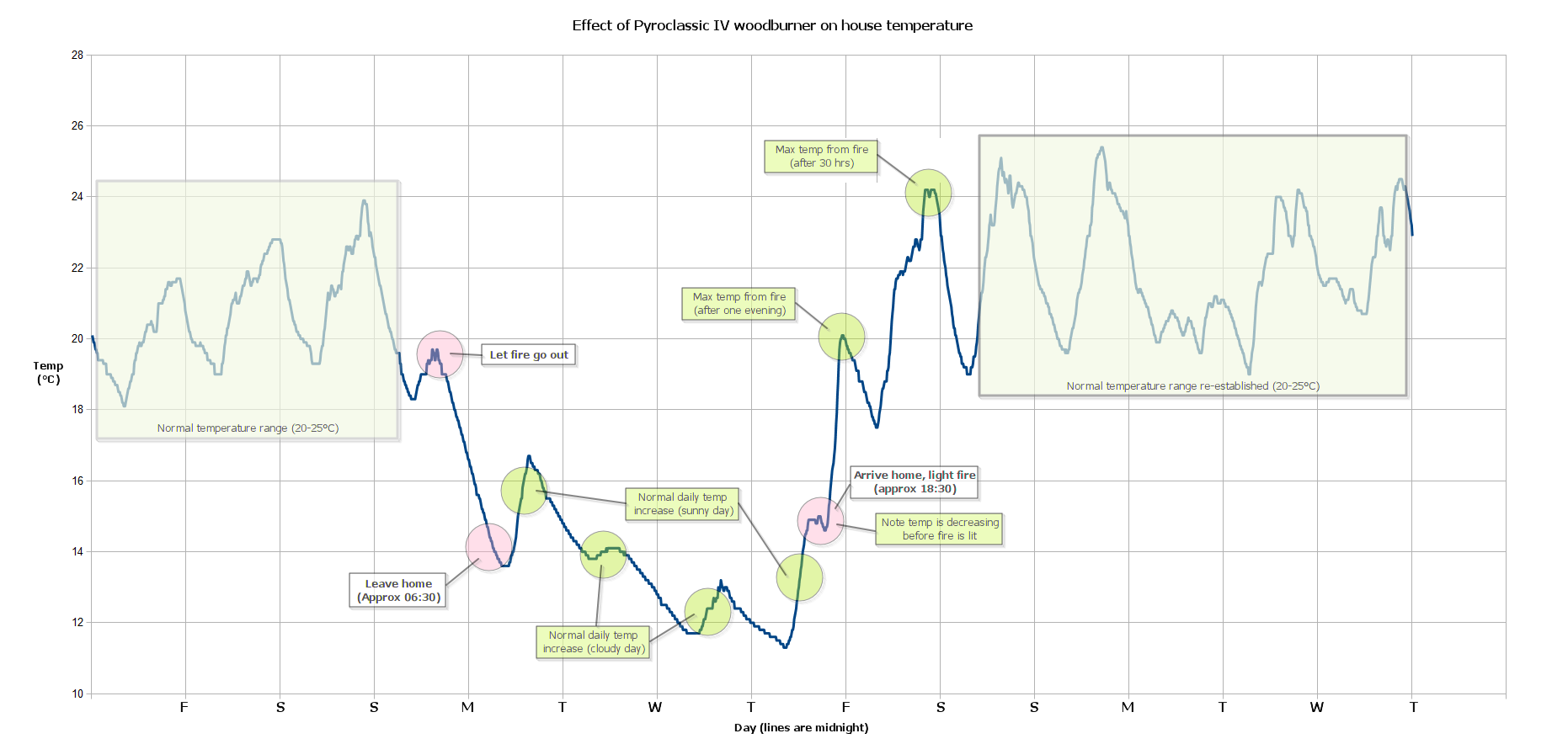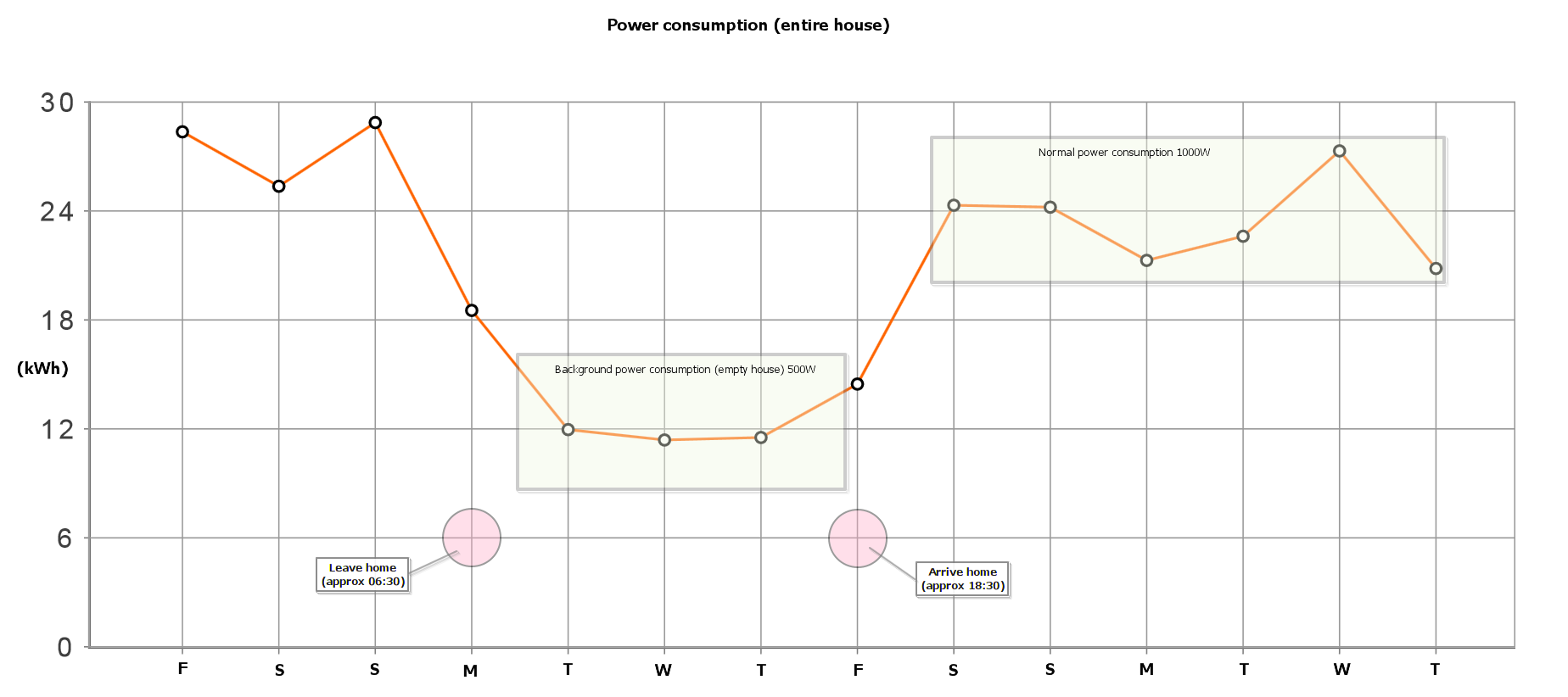TLDR: Pyroclassic woodfire is efficient, but leave it burning 24/7 for best results. Will heat entire house if reasonably well insulated and draught proofed.
A recent project has been a major structural upgrade to our downstairs lounge and dining area – we removed two back to back open fireplaces and a wall with extensive storage cupboards on both sides between our lounge and dining room to open up and increase the size of our living area. At the same time we strengthened all the walls, fitted support lintels for the upper storey, and fully insulated the room, then restored and reinstated the original rimu TG&V panelling and fitted a new ceiling. We installed a Pyroclassic IV woodburner in the same location as the original fireplaces, on a renovated concrete foundation with a mill finish steel hearth set flush with the floor. The structure around the fire needed to be retained because it supports the upper storey.
House is a 1920s California bungalow, with an upper storey added in the 1980s. Timber weatherboard, steel roof, single glazed timber windows, various degrees of insulation (varying from none to the maximum possible for the construction). Very sunny but exposed and windy location.
We recently traveled away for a few days, so were able to observe the effects on house temperature as the woodburner was shut down and restarted.
This is the context of the installation (click on images to embiggen):
We were away from Monday to Friday in early September, and let the fire go out before we left. Normally the fire runs 24/7 with no problems – in fact it is easier and warmer to keep the fire going for months at a time (we lit the fire in June, and let it go out in September). We find that the fire generally heats the entire house – we have a heat transfer system that can duct excess heat to the upstairs lounge if we are using that room; our house has always been difficult to heat previously, as it has a lot of open doorways and open stairs.
There is a temperature datalogger in the lounge, some distance away from the fire as shown in the image above. This recorded the data for the period we were away, shown in the chart below:
The Pyroclassic is a massive (but small) woodburner that takes quite some time to heat up, and can be difficult to start from cold, so we’d always felt that to get the best out of the Pyroclassic you need to keep it burning 24/7, and the chart seems to confirm this. The chart shows that after letting the fire go out, it takes some time for the room temperature to fall to the ambient level, and even longer to climb from that level to the normal operating range for our house. For example, it took an evening to heat the room to 20°C, and a further day to achieve 24°C. This is heating not just the lounge, but the entire house indirectly.
It seems better to keep the entire space and structure heated all the time, rather than restarting the fire every evening. We’re fortunate that we can keep the fire going 24/7 since we can add fuel at lunchtime if necessary, and we have enough storage to keep the firewood we need. The Pyroclassic is quite efficient, we burn a mixture of gum and manuka, and a couple of short manuka logs will easily burn at least 8 hrs, and still be hot enough to immediately start burning new fuel when it is added to the fire.
Most of the house heating comes from the Pyroclassic, our power usage over the same period is shown below. Background power consumption is 500W, and we normally use an additional 500W when we are home (and none of this is space heating), and I don’t believe this is a significant contribution to heating this area. Normal occupancy is two humans and one (or two) greyhounds.
Our experience with the Pyroclassic fire has been overwhelmingly positive. While it does require some organisation to get the best out of the firewood supply, and it isn’t the cheapest or most convenient way to heat the house, it produces more heat output than we would reasonably expect from even a large heatpump installation. Here are some tips from our experience:
- Use gum, manuka or other dense wood. Clean untreated unpainted demolition timber (rimu, matai etc – not pine) is also good if available. Cheaper woods like pine or macrocarpa don’t burn as long and so require more space for storage and more handling and stacking. Macrocarpa seems to attract more cockroaches for some reason.
- Use dry wood. The importance of this cannot be overstated.
- Condition the wood before burning. Design your fireplace with storage so that the wood can be dried beside the fire. There is a reasonable amount of airflow due to convection, and the sides of the burner do not get hot enough to be a hazard, but are very effective at drying stacked wood. Do not stack wood higher than the top of the burner as that would create a fire risk.
- Having enough fireside storage makes the task of managing firewood much easier, we only have to get more wood in every few days.
- Leave the fire burning 24/7, as it can be harder to start when it is cold and is more effective at heating if everything is kept up to temperature.
- Get in the habit of raking the coals forward before putting new wood in towards the back, but on top of the coals. When burning overnight the coals should have formed ash which you can remove the next morning. The burner doesn’t need a bed of ash to improve insulation, the ceramic liner does the same thing. The curvature of the liner also focuses heat into the new fuel.
- Even when the fire looks like it is nearly out, putting good dry fuel in it and leaving the boost control shut should get the fire going, it may take 10 minutes or so to show flames.
- Burn logs in pairs. This increases the surface areas that start burning, since the logs quickly start burning on the two centre faces.
- Be careful with the old ashes, they are a significant fire risk. We keep a stainless steel bucket on the hearth to put ashes in, and empty the bucket every few weeks.
- Consider using the top to cook on, it is very effective. You will need a trivet to reduce the heat transferred to your cookware.
- Expect the amount of dust in the house to increase; you will also have to deal with some mess around the fire, so having an easy to clean hearth is worth considering.
The lounge renovation, insulation and particularly the fire installation have totally transformed the house. Previously the entire downstairs area was quite cold and damp, and difficult to heat. Now it is spacious, light and very warm, with the normal temperature range, even in coldest winter, lying between 20-25°C.
Links:
Pyroclassic woodburner website: http://www.pyroclassic.co.nz/




Hi I see you say not to use pine but if that is what is mainly available is it only because it burns quicker rather than the amount of heat it produces? Thanks
@Penny, I avoid burning pine demolition timber as pine used for building is usually treated, and it is not always possible to identify if the treatment is hazardous to burn or will contaminate the burner. There was a period in the late 90s/early 00s when untreated but dry pine was permitted to be used for building, but outside of this time period pine is almost always treated.
Pine is OK as firewood, but because it isn’t as heavy as better firewood, to get the same heat output you have to burn more of it and it burns faster. Firewood is sold by volume, (not weight) so it is often a better deal to go for denser species of wood, or a dense species of pine. Heavier dry wood burns longer in the fireplace, so you spend less time tending the fire; it will burn better and longer overnight, and you have to handle, manage and store less volume of wood for the same heat output – quite important if you have limited space for storage. I need our fire to burn all day and right through the night, essentially unattended and I can only do this with denser wood.
Burning what is available is fine, and is a good use of wood that wouldn’t otherwise be used, but I approached the fireplace project on the basis of solving the problem of how to effectively heat our house, so I don’t object too much to paying a premium for decent firewood – it is our only form of space heating.
Thank you that all makes sense. We usually buy pre cut and split pine and some gum for our fire which is a Yunka wedj. If we get a pyroclassic for our daughters house we will probably be seasoning the wood at our house as we have more room. Thanks again for your reply
Hi Do you know how much wood (say in tonnes) you used between that June Sept period?
Ps Thanks for the article.
@Andrew, sorry, I don’t know the weight of wood in tonnes, but would guess that it may have been a bit over 3.6m3, maybe 4.5m3 – a bit over a cord. Bear in mind this was for a fire burning 24/7 so actually is a remarkably small amount in that context.
Hello Just checking in to see if you have had any hassles to date with the Pyroclassic IV? We are looking at installing one for 1. Heat ouput 2. Wetback 3.Reduced wood consumption 4. Cooking.
A few reviews have mentioned flue issues and damage, with the seller stating it was caused by moist wood. You seem extremely positive about it…..just making sure after another winter you still feel the same way!
Thank you – Stephanie
@Stephanie, we are almost through our 3rd winter with the Pyroclassic and we couldn’t be happier.
I’m aware that there is some discussion about problems in one of the Ecobob forums, but our experience couldn’t be more different; in fact, almost all of the problems related there are due to people not operating the burner correctly, or knowing better than the manufacturer how to operate it – in fact doing the exact opposite of what the instructions say. I was appalled to see somebody modifying their burner, when they clearly had no idea what they were doing or how it works. In some cases, I would suspect the fire has been installed incorrectly – the flue detail is different to all other fires and most installers are not aware of this.
Having said that, the Pyroclassic is not without faults and compromises; the flue does tend to need cleaning reasonably often and you definitely need to be using dry firewood, but I’d say that for people who aren’t organised enough to ensure they have enough dry wood, maybe a fire isn’t the best choice of heating anyway. I have some reservations about the current configuration which has insulation that partly covers the primary air inlet holes, which are above the door behind the front panel. I believe this may be reducing the output from some burners and causing some of the issues reported.
A common thread seems to be low heat output, and I can see how this misconception could occur. The Pyroclassic takes ages to heat up (hours in fact) so isn’t suited to intermittent use, you really need to be using it to heat your house 24hrs a day. If this isn’t the case, there will be better alternatives. The Pyroclassic is very good at heating the whole house structure evenly, not so good if you want a “feel good” hot spot to huddle around while the rest of the house freezes.
I hear mixed reports about wetbacks, but the common factor is that the heat exchanger cokes up quite quickly. My sister’s wetback doesn’t work at all, though a friend’s works very well – I guess it depends on the distance and the competence of the installer. We have solar hot water and a wet back would be quite expensive and not efficient due to a long run, so we are glad not to have the complications of a wetback in our Pyroclassic.
Our Pyroclassic is quite frugal when it comes to wood consumption – I don’t understand comments about having to put wood in every hour. I generally put wood in every 4 hours (and then, only 2 pieces side by side) and it will burn for at least 10 hours overnight if I use a couple of manuka logs. New wood in the morning will ignite within about 30 seconds as the coals are still very hot. One trick is to put the firewood as far back as possible, the confined space makes the fire burn hotter and more efficiently, and it also heats the air tubes for secondary combustion better, too.
Cooking? We do this all the time. Tonights dinner was cooked on the Pyroclassic, we probably cook on it a couple of times every week. Great for slow meals like lamb shanks, and my sister and her children do baking on their Pyroclassic.
I can see why there are some criticisms of the Pyroclassic, but really, if you think about what you are doing, and are organised, there shouldn’t be any problems. We are certainly very happy with ours.
We also purchased a pyroclastic IV and are very pleased. It is clean, does a great job heating the house, lasts the night, easy to start, looks modern and is a nice feature. We highly recommend that someone who knows the product installs it, as we had some ridiculous suggestions for the installation until we employed an experienced installer who knew what he was doing and gave us great advice and was very reasonable with his price.
this is a great wood heater, the only disadvantage is the high purchase price.
Agree about the high purchase price, but if you factor in the other costs of installation (permits, flue components, installation labour) the difference in price isn’t so great proportionally. Add in the lower cost of fuel (since it burns more efficiently), and the requirement for less wood storage, and less time managing it, and it becomes fairly hard to see how this can’t be a better deal when viewed over the life of the burner.
Definitely need a competent installer, and our installer wasn’t; poor quality installation and unaware of the correct way to configure the flue (which is all detailed on the Pyroclassic web site). You really need to keep an eye on the installation process if possible – I did 80% of the work myself, and Fireworx still stuffed it up…
I just had a pyro installed and so far I am happy. I got almost $2000 off the price (purchased last year when they were running $1000 off the firebox with a free flue kit). I got the raised hearth with it and it is a must IMHO. Your right about it not producing a ‘hot spot’ and as a result it doesn’t feel like it is producing as much as the kent tile fire it has replaced. What absolutely blows me away is how little wood it uses. At the moment it is using around half the amount of wood that the kent used per hour. Time will tell as we get further into winter and it starts to get colder outside and I will try a little harder to have it burn all night 🙂
Im in vic Australia and have had a pyroclassic for 3 or 4 years now with the wetback and haven’t had any troubles at all, best bloody fire ever. Had to change the way i cut my wood lengths but I’ve got it all sorted now, always a year or so in front with nice dry wood. I get easily 12+ hour burns out of mine, i think best was 14-15 hours one night. Initial purchase is steep but the amount of less wood you burn is worth it. More people should have them their so clean and efficient its unbelievable.
We have had a Pyroclassic IV for about 8 or 9 years now and love it. Living on a country block, we burn whatever trees have recently been cut or felled – a mixture of gum, wattle, macrocarpa and occasionally pine. Burning dry wood, as the author mentioned, is absolutely crucial, so it pays to dry and season the wood for a few years. I agree that running 24/7 is the best way to operate these stoves. I only clean the ashes out about once every 3-4 weeks as the stove burns so completely there is almost nothing left. We had a wetback which was good, but then got gas hot water, and I think we get more heat into the house now. I will try to get some manuka for next year to use for the overnight burn, though gum doesn’t do a bad job. Generally I split the wood down to about 4 inches width but overnight logs are probably better about 6 inches diameter or even bigger provided you can fit then into the stove. We have the 4 inch flue, and I noticed new Pyroclassic stoves are now sold with a 6 inch flue – perhaps this gives a better draw when you are trying to light the fire. All in all, though, a great fire and we are still very happy with the purchase.